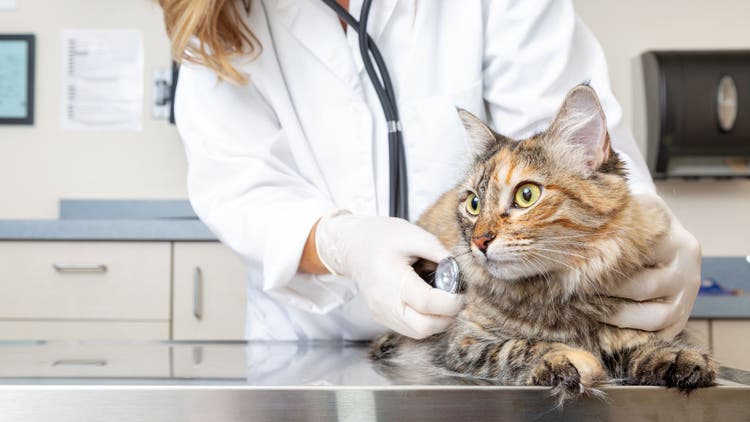
Revolution® PLUS (Selamectin and Sarolaner Topical Solution) for Cats
Overview of Revolution® PLUS for Cats
- Revolution® PLUS, is a drug released in 2019 that is a combination of two drugs, Selamectin and Sarolaner. Selamectin, is the ingredient in the traditionally used Revolution® in dogs and cats.
- Selamectin is a semi synthetic avermectin antiparasitic agent primarily used to kill adult fleas on cats. It also kills ear mites, feline hookworms, feline roundworms, sarcoptic mange, and has some tick repellent properties. It also prevents heartworm infection. It works by interfering with the nervous system of insects and some worms, resulting in death. Selamectin belongs to the macrocyclic lactone class of parasiticides.
- Sarolaner, an active ingredient in Simperica®, kills adult fleas and ticks. Sarolaner belongs to the isoxazoline of parasiticides.
- Selamectin and Sarolaner is a topical solution that collects in the oils of the skin and in the hair follicles. It is absorbed into the body and circulates through the bloodstream.
- Together, Selamectin and Sarolaner is known as Revolution® PLUS, providing an effective comprehensive parasite prevention solution for cats.
- The effects of Selamectin and Sarolaner last about 30 days.
- Selamectin and Sarolaner is a prescription drug and can only be obtained from a veterinarian or by prescription from a veterinarian.
Brand Names and Other Names of Selamectin and Sarolaner
- This drug is registered for use in animals only.
- Human formulations: None
- Veterinary formulations: Revolution® PLUS (Zoetis)
Uses of Selamectin and Sarolaner for Cats
- In cats, Selamectin and Sarolaner (Revolution® PLUS) is used to treat and control fleas, ear mites, hookworms (Ancylostoma tubaeforme) and roundworms (Toxocara cati), ticks and prevent heartworm disease in cats.
- Control of tick infestation includes Ixodes scapularis (black legged tick), Ambylomma maculatum (Gulf Coast tick), and Dermacentor variabilis (American Dog Tick).
- It has also been used to treat Cheyletiellosis (Walking Dandruff Mite) in cats.
Precautions and Side Effects with Revolution® PLUS for Cats
- While generally safe and effective when prescribed by a veterinarian, Selamectin and Sarolaner can cause side effects in some cats.
Selamectin and Sarolaner should not be used in animals with known hypersensitivity or allergy to the drug. Revolution® PLUS should be used with caution in cats with neurologic disease. - This product is not recommended for use in debilitated or underweight animals.
- Revolution® PLUS is not recommended for use in kittens less than 8 weeks of age.
- Selamectin and Sarolaner (Revolution® PLUS) is a clear to slightly yellow topical agent. Temporary irritation and hair loss at the site of application is possible.
- The safety of Revolution® PLUS has not been determined in pregnant, breeding, or lactating cats.
- Side effects are rare. Side effects associated with Selamectin may include vomiting, diarrhea, anorexia, drooling, lethargy, or muscle tremors. Side effects of Sarolaner may include neurologic reactions such as trouble walking (ataxia), muscle tremors, and seizures.
How Selamectin and Sarolaner Is Supplied
Selamectin is available in the following single dose sized tubes based on the cat’s weight:
- Weight 2.8 to 5.5 pounds – 0.25 mL total solution (15 mg Selamectin, 2.5 mg Sarolaner per tube)
- Weight 5.6 to 11 pounds – 0.5 mL total solution (30 mg Selamectin, 5 mg Sarolaner per tube)
- Weight 11.1 to 22 pounds – 1 mL total solution (60 mg Selamectin, 10 mg Sarolaner per tube)
Revolution® PLUS is recommended for cats 8 weeks and older. Cats over 22 pounds should be treated with the appropriate combination of tubes.
Dosing Information of Selamectin and Sarolaner for Cats
- Medication should never be administered without first consulting your veterinarian.
- The dose of Revolution® PLUS dose is based on the weight of the cat and pipettes are available as 0.25 mL for cats up to 5.5 pounds, 0.50 mL for cats 5.6 to 11 pounds, 1 mL for cats 11.1 to 22 pounds. The milligram strength is listed above.
- The duration of administration depends on the condition being treated, response to the medication and the development of any adverse effects. The recommended treatment is monthly topical year-round. Be certain to complete the prescription unless specifically directed by your veterinarian.